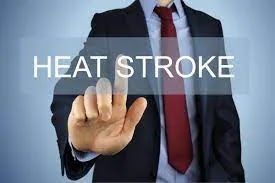Prevent heat stroke and provide first aid in the summer
To prevent heat stroke, immediately after exposure to sunlight, use the following steps: apply sunscreen, use a hat and wear light-colored clothing. Lie in the shade, if any. Drink non-caffeinated liquids such as water or sports drinks. Take breaks in the shade and do not exercise yourself if you feel the temperature rise.
1. To prevent heat stroke Keeps the body hydrated
Your body is more at risk of dehydration from the heat in summer. Therefore, it is important to stay hydrated throughout the day. Keep some salt and sugar handy and add them whenever you feel tired and exhausted. They will help maintain electrolyte balance.
Drink 2-3 liters of water every day.
Rehydration is the fastest and most effective way to prevent heat stroke. When athletes are dehydrated, they are at increased risk for heat stroke, especially during extreme heat. To stay hydrated, athletes should drink at least half their total fluid intake to replace sweat losses. This includes water, sports drinks, coffee and tea, and electrolyte-replacement beverages such as Gatorade and Pedialyte.
2. To prevent heat stroke Avoid alcohol and caffeine
Prevention Stay away from coffee and alcohol. Alcohol and caffeine dehydrate the body and can cause heat exhaustion.
By being intentional with your hydration, you can stay healthy, hydrated, and safe. Prevent heatstroke by staying well-hydrated. No matter how active you are, you should always be well-hydrated to stay healthy and avoid heatstroke and other heat-related illnesses. Caffeine can cause dehydration, increase heart rate, and have other negative effects.
3. To prevent heat stroke Snacks:
Prevention Eat easily digestible foods. Avoid junk food and opt for fruit snacks or salads instead. Avoid spicy foods and eating too many foods because they can cause acid reflux and lead to indigestion.
Snacks can prevent heat stroke if they are cold or hot. For prevention of heat stroke, always carry cold or hot food and drinks with you. Kids also like to snack on s'mores. But not too many, because they have to eat them inside a fire-resistant container.
4. To prevent heat stroke Always cover up when outdoors
If you have to go out in the sun, the scarf will be your Savior. When traveling, keep your head and face covered. But don't tie her too tightly or make her feel suffocated. Wear a hat if you don't like a scarf. Or you can cover your umbrella to protect it from the sun.
Prevent heat stroke by staying cool and hydrated. When you first feel heat exhaustion, it’s already too late. Stay cool and hydrated by covering up when you’re outside and drinking plenty of water. You can also take a cool shower or bath to feel better faster.
5. To prevent heat stroke Apply sunscreen cream
Exposure to sunlight can lead to sunburn and increased melanin formation. To prevent skin aging and UV damage, wear sunscreen. Choose one that provides protection against UVB, UVA1, and UVA2. Reapply two hours after sun exposure, excessive sweating, or swimming.
If you don’t regularly apply sunscreen on your face, now is the time to put it on, at least every two hours. It may also be a good time to reapply if you have just been in the sun and are about to go back out for the day.
to prevent heat stroke apply zinc-based sunscreen creams that contain at least
6. Wearing sunglasses
Your eyes suffer a lot during the summer. Conjunctivitis and dry eyes are common diseases in summer. Wearing sunglasses outdoors helps protect against UV rays.
When you wear sunglasses, your eyes can become dry at the sides and top, which can lead to overheating. Some doctors recommend that you wear sunglasses in the heat and that you bring a change of lens for sunny days to keep your eyes from becoming dry.
7 To prevent heat stroke Soothes the skin after sunbathing
With temperatures as high as Hanoi in the past few days, the skin is prone to redness and sunburn; you should carry gel products extracted from cucumber and aloe vera with cooling and soothing properties with you; it helps to soothe damaged skin.
How to provide first aid in case of heat stroke
When meeting a person with a heat stroke, first aid steps should be taken: put the victim in the shade, undress, and sprinkle cold or slightly warm water on the victim. To enhance sweating and evaporation, apply ice compresses to the armpits and groin.
If the sufferer is conscious and able to drink, give him cool or cold water that does not contain alcohol and caffeine.
Monitor the temperature of the injured person regularly, constantly cooling him until the temperature drops to about 38.3 - 38.8 degrees Celsius.
Call 911 if possible. If the emergency services are far away or are not immediately available, you can ask the medical staff how to provide first aid to the victim.
Perform cardiopulmonary resuscitation (CPR) if the patient has lost consciousness and does not show signs of blood circulation such as spontaneous breathing, coughing, or movement.
summary:
Prevention is always better than treatment. The sooner you can identify and treat a condition, the better your chance of a successful outcome. The same goes for heat stroke. The only way to prevent heat stroke is to prevent heat illness in the first place.
Heat stroke is the most common cause of death for people who become dehydrated and overheated. The best defense against heat stroke is to prevent it from happening in the first place. Here are some tips for staying cool and avoiding heat stroke: Stay hydrated. Wet yourself down with cool water and get rid of any excess heat.

